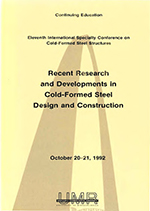Location
Saint Louis, Missouri
Session Dates
20 Aug 1992 - 21 Aug 1992
Abstract
It is recognised that structural design efficiency in domestic and similar structures can be improved when the composite behaviour and contribution of all materials in the permanent structure can be fully recognised in the structural design of the frame. The ability to achieve this Improvement is currently limited by the need 10 rely on empirical test results for standardised building elements when considering the composite behaviour of the entire structure. The existing test methodology for determining the shear strength of plasterboard lined steel stud walls leads to an excessively conservative design of the complete structure. Since the test configuration is for isolated test panels, the absence of continuity of the plasterboard lining around a set corner is not included in the test procedure. A test program has been devised and carried out to explore the effect of the set corner on the performance of shear test panels. A dramatic improvement in both diaphragm shear strength and shear stiffness has been achieved in these tests supporting a proposal to amend the standard lest methodology to Include set corners.
Department(s)
Civil, Architectural and Environmental Engineering
Research Center/Lab(s)
Wei-Wen Yu Center for Cold-Formed Steel Structures
Meeting Name
11th International Specialty Conference on Cold-Formed Steel Structures
Publisher
University of Missouri--Rolla
Document Version
Final Version
Rights
© 1992 University of Missouri--Rolla, All rights reserved.
Document Type
Article - Conference proceedings
File Type
text
Language
English
Recommended Citation
Golledge, B.; Clayton, T.; and Reardon, G., "Racking Performance of Plasterboard-Clad Steel Stud Walls" (1992). CCFSS Proceedings of International Specialty Conference on Cold-Formed Steel Structures (1971 - 2018). 3.
https://scholarsmine.mst.edu/isccss/11iccfss/11iccfss-session7/3
Racking Performance of Plasterboard-Clad Steel Stud Walls
Saint Louis, Missouri
It is recognised that structural design efficiency in domestic and similar structures can be improved when the composite behaviour and contribution of all materials in the permanent structure can be fully recognised in the structural design of the frame. The ability to achieve this Improvement is currently limited by the need 10 rely on empirical test results for standardised building elements when considering the composite behaviour of the entire structure. The existing test methodology for determining the shear strength of plasterboard lined steel stud walls leads to an excessively conservative design of the complete structure. Since the test configuration is for isolated test panels, the absence of continuity of the plasterboard lining around a set corner is not included in the test procedure. A test program has been devised and carried out to explore the effect of the set corner on the performance of shear test panels. A dramatic improvement in both diaphragm shear strength and shear stiffness has been achieved in these tests supporting a proposal to amend the standard lest methodology to Include set corners.



